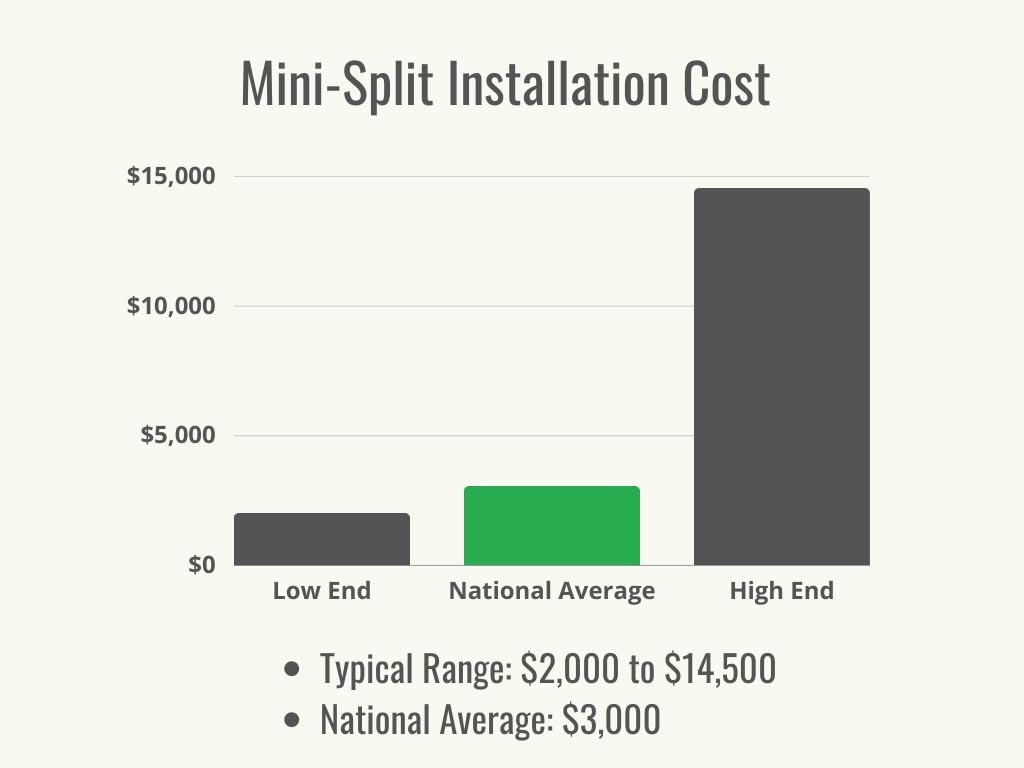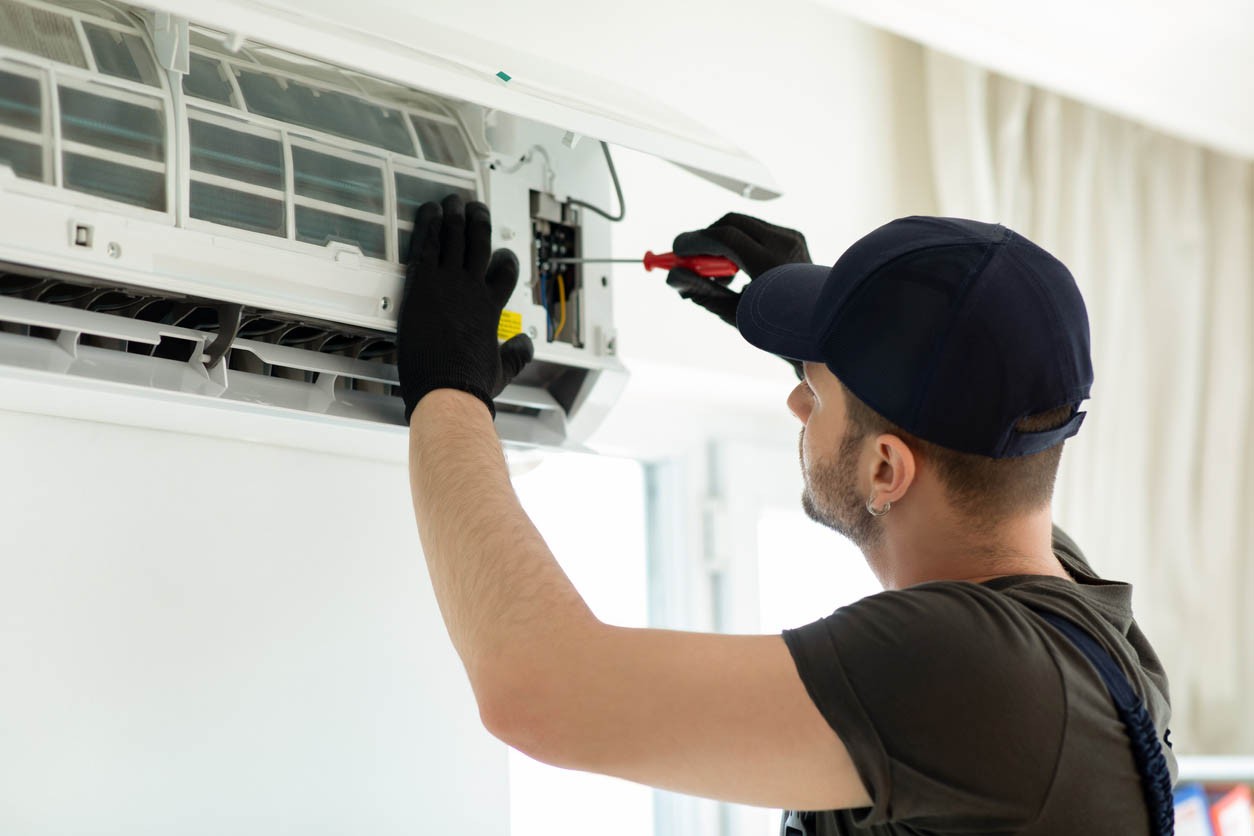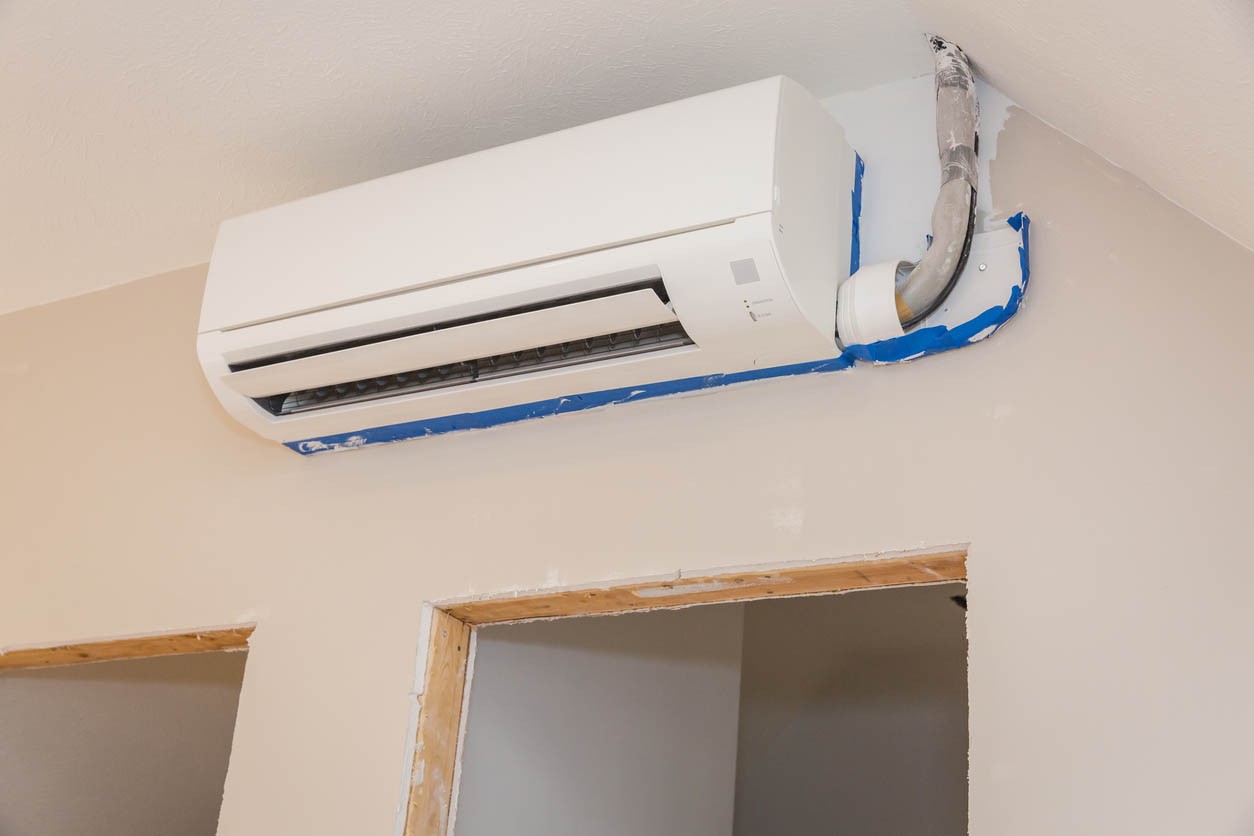Are you looking to enhance the comfort of your home with a mini split system? At HOW.EDU.VN, we understand that one of the first questions you’ll have is about the cost. Determining the true cost for mini split installation involves several factors, including equipment prices and labor costs. Discover the factors influencing mini-split AC system expenses and find expert insights to help you make an informed decision.
1. Understanding Ductless Mini-Split Air Conditioner Systems
Ductless mini-split air conditioners offer a flexible solution for heating and cooling homes without the need for extensive ductwork. These systems consist of an outdoor compressor/condenser and one or more indoor air-handling units, connected by refrigerant lines. This setup allows for individualized temperature control in different rooms or “zones.” Mini-splits are particularly useful for homes without existing ductwork, additions, or specific areas needing supplemental heating or cooling.
2. Factors Influencing Mini-Split Installation Costs
The total cost of mini-split installation can vary significantly based on several key factors. Understanding these elements helps homeowners budget effectively and make informed decisions.
2.1. Unit Size and BTU Capacity
The size of the mini-split unit, measured in British Thermal Units (BTUs), directly impacts the cost. A larger BTU capacity is required for larger spaces. Units typically range from 9,000 to 36,000 BTUs, with costs varying accordingly. A 12,000 BTU unit, suitable for an average-sized room, generally costs between $700 and $3,200.
2.2. Single-Zone vs. Multi-Zone Systems
Single-zone systems are designed for one room, while multi-zone systems can support multiple indoor units. Multi-zone systems require a more powerful outdoor unit and additional indoor units, increasing the overall cost.
2.3. Type of Indoor Unit
Indoor units come in various types, including wall-mounted, floor-mounted, ceiling-mounted, and ceiling cassette models. Wall-mounted units are the most common and typically the least expensive. Ceiling cassettes offer a more discreet option but often come with a higher price tag.
2.4. Unit Efficiency (SEER Rating)
The Seasonal Energy Efficiency Ratio (SEER) rating indicates the unit’s energy efficiency. Higher SEER ratings mean greater energy savings but also a higher initial cost. Energy-efficient units may qualify for rebates and tax credits, offsetting some of the initial expense.
2.5. Brand and Model
The brand and model of the mini-split system also affect the cost. Well-known brands like Daikin, Fujitsu, Mitsubishi, Panasonic, and Rheem generally come with a higher price point due to their reputation for quality and reliability.
2.6. Installation Location and Complexity
The location of the indoor and outdoor units, as well as the complexity of the installation, can impact labor costs. Installations on upper floors or in difficult-to-reach areas may require additional time and effort.
2.7. Labor Costs
Labor costs can vary depending on the region and the HVAC technician’s experience. Most mini-split installations take between 5 and 10 hours, with labor costs ranging from $300 to $1,500.
2.8. Refrigerant Lines
Refrigerant lines connect the indoor and outdoor units. The length and complexity of these lines can affect the overall cost, with an average cost of $7 per foot for materials.
2.9. Additional Electrical Work
If your home lacks a dedicated 110- or 200-volt electrical circuit, you may need to hire an electrician to install one. This can add an extra $250 or more to the total cost.
3. Average Mini-Split Installation Costs: A Detailed Breakdown
To provide a clearer picture of potential costs, here’s a breakdown of average mini-split installation expenses:
3.1. Single-Zone Systems
Single-zone systems, ideal for individual rooms or small spaces, typically range from $2,000 to $8,800, including the unit and installation.
3.2. Multi-Zone Systems
Multi-zone systems, capable of heating or cooling multiple rooms, range from $2,700 to $18,000, depending on the number of zones and the complexity of the installation.
3.3. Cost by Zone
| Number of Zones | Average Cost Range |
|---|---|
| Single Zone | $2,000 – $8,800 |
| Two Zones | $2,700 – $11,100 |
| Three Zones | $3,400 – $13,400 |
| Four Zones | $4,100 – $15,700 |
| Five Zones | $4,800 – $18,000 |



3.4. Cost by Unit Type
| Unit Type | Average Cost |
|---|---|
| Wall-Mounted | $400 – $1,000 |
| Floor-Mounted | $1,300 – $4,000 |
| Ceiling-Mounted | $700 – $2,000 |
| Ceiling Cassette | $500 – $2,000 |
4. Additional Costs and Considerations
Beyond the basic installation, several additional costs may arise.
4.1. Permits
Most municipalities require permits for HVAC installations. Permit costs can range from $250 to $400.
4.2. Electrical Work
Upgrading or installing new electrical circuits can add $250 or more to the project cost.
4.3. Carpentry Work
Cutting holes through exterior walls may require carpentry work, costing between $35 and $100 per hour.
4.4. Old HVAC System Removal
Removing an old HVAC system can cost an additional $80 to $150.
4.5. Accessories and Upgrades
Optional accessories and upgrades, such as condensate removal pumps, condenser stands, and wireless remote controllers, can add to the total cost.
4.6. Tax Credits and Rebates
Energy-efficient mini-split systems may qualify for federal, state, or local tax credits and rebates.
4.7. Warranties
Most manufacturers offer warranties on their mini-split systems. Consider purchasing a home warranty for HVAC to cover potential repairs or replacements.
5. Ductless Mini-Split vs. Central AC Installation
When considering a new AC system, homeowners often compare ductless mini-splits with central AC systems.
5.1. Cost Comparison
Mini-split systems generally cost less to install than central AC systems. The average cost for mini-split installation is around $3,000, while central AC installation averages $5,860.
5.2. Efficiency
Mini-splits can be 20% to 60% more efficient than central AC systems, particularly in homes without existing ductwork.
5.3. Suitability
Mini-splits are ideal for single-room cooling or older homes without ductwork, while central AC is better suited for homes with existing ductwork or those requiring even cooling throughout.
6. Benefits of Choosing a Ductless Mini-Split System
Mini-split systems offer several advantages over traditional HVAC systems.
6.1. Efficiency and Sustainability
Mini-splits use conduits and wiring instead of bulky ducts, reducing air leaks and improving energy efficiency. They also require fewer materials and less invasive installation, minimizing environmental impact.
6.2. Affordability
Mini-splits have fewer components, resulting in lower material costs and potentially lower labor costs.
6.3. Low Noise
Mini-split systems operate quietly, typically around 32 decibels, compared to central AC systems, which can range from 50 to 80 decibels.
6.4. Room-Specific Temperature Adjustment
Multi-zone mini-splits allow for individualized temperature control in each room, enhancing comfort and reducing energy waste.
6.5. Increased Home Value
Installing a mini-split system can increase your home’s value by improving comfort and energy efficiency, especially in older homes without central AC.
7. Mini-Split Installation: DIY vs. Hiring a Professional
While DIY installation may seem tempting, hiring a professional HVAC technician is generally recommended.
7.1. Expertise and Proper Installation
Professionals ensure proper sizing, installation, and refrigerant handling, which is crucial for optimal performance and safety.
7.2. Warranty Validity
Many manufacturers require professional installation for the warranty to be valid.
7.3. Electrical and Other Considerations
Professionals can identify and address any electrical or structural issues that may arise during installation.
8. How to Save Money on Mini-Split Installation
Despite the numerous benefits, the initial investment can be significant. Here are some ways to reduce the cost of mini-split installation:
- Fewer Zones: Install units only in rooms that require temperature control.
- Single- vs. Multi-Zone: Determine if a single-zone system can meet your needs.
- Consider Your Needs: Choose a unit that provides only heating or cooling, if that’s all you need.
- Upgrades: Look for units with built-in sensors that automatically shut off when the desired temperature is reached.
- Weigh Costs: Balance up-front costs with long-term energy savings.
- Shop Around: Obtain quotes from multiple HVAC companies.
- Off-Season Installation: Consider installing during the off-season when demand and prices may be lower.
- Discounts: Ask about discounts for seniors, military personnel, or first responders.
9. Questions to Ask a Professional HVAC Technician
Asking the right questions can help you choose the best HVAC company and ensure a smooth installation process.
- How long have you worked on mini-split installations?
- How common are mini-splits in my region?
- Do you offer a free consultation to assess the size and type of unit I need?
- Will my home need more than five units? If so, is it better to install a larger unit or two smaller units?
- Can I review a line-item invoice?
- What are the payment terms?
- What if we end up needing an electrician? Do you have someone on staff?
- Will we need a permit?
- What brand of mini-split should I purchase if I’m concerned about my budget? What about if I’m concerned about efficiency?
- Are there any rebates or tax credits I can take advantage of?
- What are the pros and cons of wall, ceiling, and recessed mountings?
- How long will it take to install?
- What kind of problems or concerns should I call you about after installation?
- Do you offer any guarantees, warranties, or maintenance programs?
10. Frequently Asked Questions (FAQs)
Here are some common questions about mini-split installation costs:
10.1. Do mini-splits add value to a home?
Yes, mini-splits improve the overall comfort level in the home, increasing its value.
10.2. Do you need an electrician to install a mini-split?
Possibly. If your home lacks a dedicated electrical circuit, you’ll need an electrician to install one.
10.3. What size breaker do I need for a mini-split?
It depends on the size of the unit. A 15-amp breaker can handle up to 24,000 BTUs, while a 30-amp breaker is sufficient for up to 60,000 BTUs.
10.4. Can a mini-split cool a whole house?
Yes, but it depends on the size of the house. Multi-zone systems can accommodate multiple rooms.
10.5. How long do mini-split air conditioners last?
Mini-split systems typically last between 15 and 20 years with proper maintenance.
10.6. Can you run a mini-split all day?
Yes, mini-split systems are designed to run continuously and efficiently.
10.7. How much electricity does a mini-split use?
On average, mini-split systems use between 700 and 2,000 watts per hour.
10.8. Do mini-splits remove humidity?
Yes, mini-splits can remove humidity when switched to dry mode.
11. Expert Consultation at HOW.EDU.VN
Navigating the complexities of mini-split installation costs can be overwhelming. At HOW.EDU.VN, we connect you with leading Ph.D. experts who provide personalized guidance and solutions tailored to your specific needs. Our team of over 100 renowned experts ensures you receive accurate, reliable, and actionable advice.
11.1. Personalized Guidance
Our experts offer personalized consultations to address your unique challenges and provide customized solutions.
11.2. Cost-Effective Solutions
We help you identify cost-effective strategies and options to maximize your investment in a mini-split system.
11.3. Comprehensive Support
From initial assessment to final installation, our experts provide comprehensive support throughout the entire process.
12. Contact HOW.EDU.VN for Expert Advice
Don’t navigate the complexities of mini-split installation alone. Contact HOW.EDU.VN today to connect with our team of expert Ph.D. consultants.
Address: 456 Expertise Plaza, Consult City, CA 90210, United States
WhatsApp: +1 (310) 555-1212
Website: HOW.EDU.VN
At HOW.EDU.VN, we understand the challenges you face when seeking expert advice. Finding qualified professionals, ensuring confidentiality, and receiving practical solutions can be daunting. Our platform simplifies this process, offering direct access to top-tier experts who provide tailored guidance to meet your specific needs.
Ready to enhance your home’s comfort and efficiency with a mini-split system? Contact us today to schedule a consultation with one of our leading experts.
13. Real-World Benefits of Expert Consultation: Case Studies
To illustrate the value of consulting with HOW.EDU.VN’s experts, consider these anonymized case studies:
13.1. Case Study 1: Optimizing a Multi-Zone System for a Large Home
A homeowner with a large, multi-story home struggled to find an efficient and cost-effective way to heat and cool different zones. After consulting with one of our HVAC experts, they optimized their system design and installation, resulting in a 30% reduction in energy costs.
13.2. Case Study 2: Addressing Electrical Challenges in an Older Home
An owner of an older home faced significant electrical challenges when attempting to install a mini-split system. Our electrical engineering expert assessed the situation, recommended cost-effective upgrades, and ensured compliance with local codes, preventing costly rework.
13.3. Case Study 3: Maximizing Rebates and Tax Credits
A homeowner was unaware of the rebates and tax credits available for energy-efficient mini-split systems. Our finance expert identified all eligible incentives, reducing the homeowner’s out-of-pocket expenses by 20%.
These case studies demonstrate the tangible benefits of seeking expert consultation from HOW.EDU.VN. Our experts provide not only technical guidance but also strategic advice to optimize your investment and achieve your goals.
14. New Advancements in Mini-Split Technology and Installation
Stay ahead of the curve with the latest advancements in mini-split technology and installation practices:
14.1. Smart Mini-Split Systems
New smart mini-split systems offer advanced features such as Wi-Fi connectivity, smart thermostats, and mobile app control. These systems optimize energy usage and enhance comfort.
14.2. Improved Refrigerant Technology
Manufacturers are increasingly using eco-friendly refrigerants with lower global warming potential, reducing the environmental impact of mini-split systems.
14.3. Enhanced Installation Techniques
New installation techniques and tools streamline the process, reducing labor costs and ensuring precise, efficient installations.
14.4. Integration with Renewable Energy Sources
Mini-split systems can be integrated with solar panels and other renewable energy sources, further reducing energy costs and environmental impact.
14.5. Mini-Split Systems with Air Purification
Some of the latest mini-split models now come equipped with advanced air purification technologies. These features filter out dust, allergens, and pollutants, ensuring superior indoor air quality for a healthier living environment. This makes mini-splits an ideal choice for families and individuals concerned about respiratory health.
15. Meet Our Featured HVAC Expert: Dr. Emily Carter
Dr. Emily Carter is a renowned HVAC engineer and consultant at HOW.EDU.VN. With over 20 years of experience, Dr. Carter specializes in energy-efficient HVAC systems and sustainable building practices. She holds a Ph.D. in Mechanical Engineering and has published numerous articles on HVAC technology.
15.1. Expertise
- Energy-efficient HVAC systems
- Sustainable building practices
- Mini-split system design and installation
- HVAC system optimization
15.2. Credentials
- Ph.D. in Mechanical Engineering
- Certified HVAC Engineer
- LEED Accredited Professional
15.3. Recent Projects
- Optimized HVAC systems for several high-profile commercial buildings
- Developed energy-efficient HVAC solutions for residential clients
- Conducted research on sustainable HVAC technologies
15.4. Testimonials
“Dr. Carter’s expertise was invaluable in designing our energy-efficient HVAC system. Her guidance saved us thousands of dollars in energy costs.” – John Smith, Homeowner
“Dr. Carter provided exceptional consulting services and helped us optimize our HVAC system for maximum efficiency and comfort.” – Sarah Johnson, Business Owner
16. Choosing the Right Mini-Split System: A Step-by-Step Guide
Selecting the right mini-split system involves careful consideration of several factors. Here’s a step-by-step guide to help you make the best choice:
- Assess Your Needs: Determine the size of the area you need to heat or cool, as well as any specific requirements (e.g., air purification, smart features).
- Calculate BTU Requirements: Use an online calculator or consult with an HVAC professional to determine the appropriate BTU capacity for your space.
- Choose a System Type: Decide between a single-zone or multi-zone system based on your needs.
- Select an Indoor Unit Type: Choose between wall-mounted, floor-mounted, ceiling-mounted, or ceiling cassette units based on your preferences and space constraints.
- Consider Energy Efficiency: Look for a unit with a high SEER rating to maximize energy savings.
- Choose a Reputable Brand: Select a well-known brand with a reputation for quality and reliability.
- Obtain Multiple Quotes: Get quotes from several HVAC companies to compare prices and services.
- Check for Rebates and Tax Credits: Inquire about any available rebates or tax credits to reduce your costs.
- Read Reviews: Research customer reviews to assess the performance and reliability of different mini-split systems.
- Consult with an Expert: If you’re unsure, consult with an HVAC expert at HOW.EDU.VN for personalized guidance.
17. Expanding Your Knowledge: Additional Resources
To further enhance your understanding of mini-split systems and HVAC technology, consider these resources:
- Industry Associations: ASHRAE (American Society of Heating, Refrigerating and Air-Conditioning Engineers)
- Government Agencies: Energy Star, Department of Energy
- Online Forums: HVAC-Talk, DIY Home Improvement Forums
- Trade Publications: ACHR News, The Air Conditioning, Heating & Refrigeration NEWS
18. Comprehensive Table of Mini-Split Brands, Models, and Features
To assist in your decision-making process, here’s a detailed table of mini-split brands, models, and features:
| Brand | Model | BTU Range | SEER Rating | Features | Average Cost |
|---|---|---|---|---|---|
| Daikin | Emura Series | 9,000-24,000 | Up to 24.5 | Smart controls, energy-saving sensors, sleek design | $1,200 – $4,500 |
| Fujitsu | Halcyon Series | 9,000-36,000 | Up to 33.1 | Quiet operation, multiple zone options, advanced filtration | $1,100 – $8,300 |
| Mitsubishi | M-Series | 9,000-36,000 | Up to 30.5 | Hyper-heating technology, whisper-quiet operation, smart connectivity | $1,200 – $8,650 |
| Panasonic | XE Series | 9,000-24,000 | Up to 26.0 | Nanoe™ X air purification, smart controls, energy-efficient operation | $1,700 – $2,800 |
| Rheem | Inverter Series | 9,000-36,000 | Up to 22.0 | Multiple zone options, durable construction, reliable performance | $1,100 – $8,300 |
| LG | Art Cool Series | 9,000-24,000 | Up to 27.0 | Stylish design, energy-efficient performance, smart controls | $1,500 – $3,500 |
| Carrier | Performance Series | 9,000-36,000 | Up to 20.0 | Reliable performance, multiple zone options, durable construction | $1,000 – $7,500 |
| Bosch | Climate 5000 Series | 9,000-24,000 | Up to 22.0 | Energy-efficient, quiet operation, smart home integration | $1,300 – $3,000 |
19. Why Choose HOW.EDU.VN for Your Consulting Needs?
Selecting the right consulting service is crucial for making informed decisions and achieving your goals. Here’s why HOW.EDU.VN stands out as the premier choice for expert consultations:
19.1. Unmatched Expertise
At HOW.EDU.VN, we pride ourselves on providing access to a network of over 100 globally recognized Ph.D. experts across diverse fields. Each expert brings decades of experience and specialized knowledge to address your unique challenges.
19.2. Personalized Solutions
We understand that every client has unique needs and challenges. Our experts work closely with you to develop customized solutions that align with your specific goals, ensuring practical and effective outcomes.
19.3. Confidentiality and Trust
We prioritize your privacy and confidentiality. Our platform ensures secure communication and data protection, giving you peace of mind when sharing sensitive information.
19.4. Proven Track Record
Our experts have a proven track record of delivering exceptional results for clients across various industries. We provide real-world case studies and testimonials to showcase the value of our consulting services.
19.5. Comprehensive Support
From initial consultation to project completion, we offer comprehensive support to guide you through every step of the process. Our experts are committed to ensuring your satisfaction and success.
19.6. Innovation and Research
Our experts stay at the forefront of their respective fields through continuous research and innovation. We provide you with the latest insights and cutting-edge solutions to stay ahead of the competition.
19.7. Cost-Effective Solutions
We offer cost-effective consulting solutions that deliver maximum value for your investment. Our transparent pricing and flexible engagement models ensure you receive the best possible service within your budget.
19.8. Global Network
Our global network of experts allows us to provide you with diverse perspectives and solutions tailored to your specific region and industry. We leverage global best practices to drive your success.
20. Key Takeaways: How Much Does It Cost to Install a Mini-Split System?
- Cost Factors: Unit size, type, efficiency, brand, installation complexity, and labor.
- Average Costs: Single-zone ($2,000-$8,800), multi-zone ($2,700-$18,000).
- Additional Costs: Permits, electrical work, carpentry, and accessories.
- DIY vs. Professional: Professional installation is recommended for optimal performance and warranty validity.
- Saving Money: Shop around, consider your needs, and look for rebates and tax credits.
- Expert Consultation: HOW.EDU.VN offers personalized guidance from leading Ph.D. experts.
By understanding the factors that influence mini-split installation costs and seeking expert consultation, you can make informed decisions and achieve optimal comfort and energy efficiency in your home.
Ready to take the next step? Contact how.edu.vn today and let our experts guide you towards the perfect mini-split solution for your needs.
